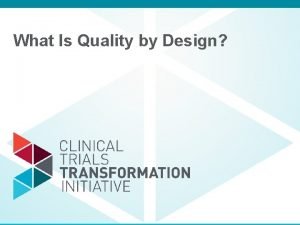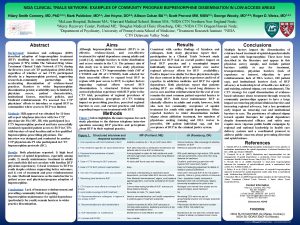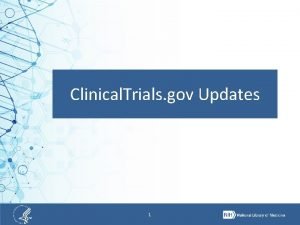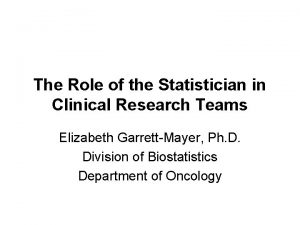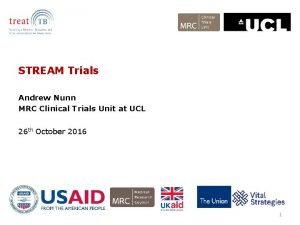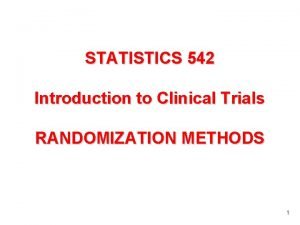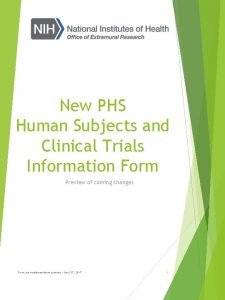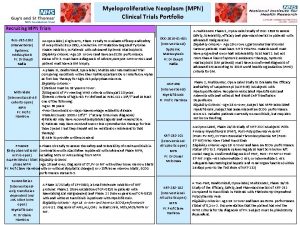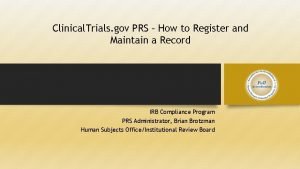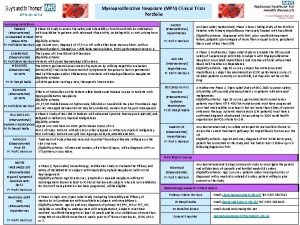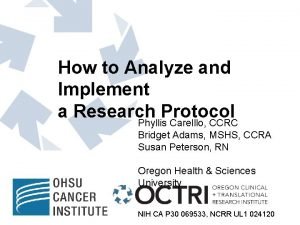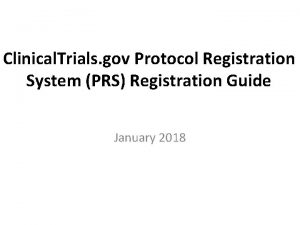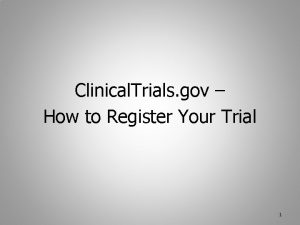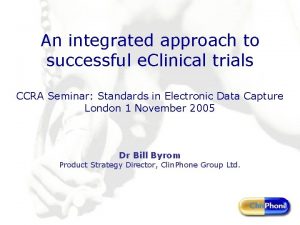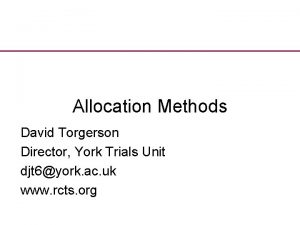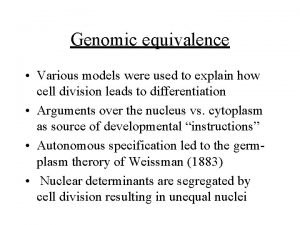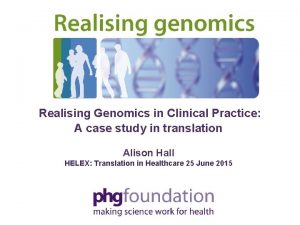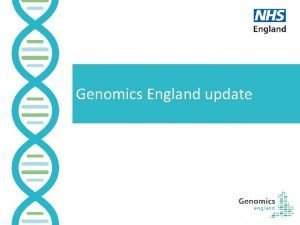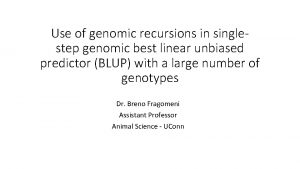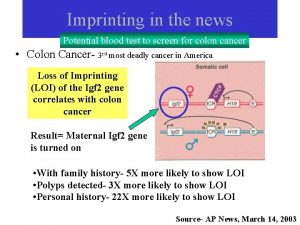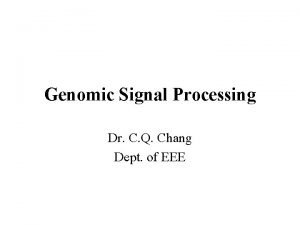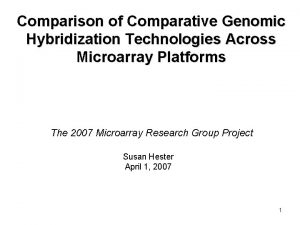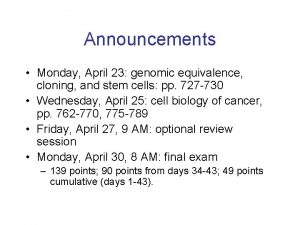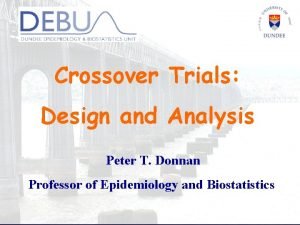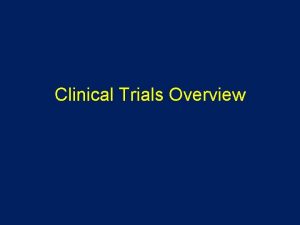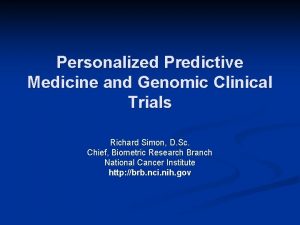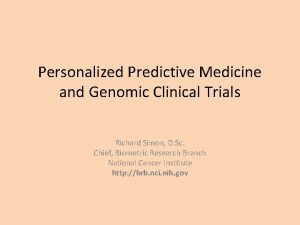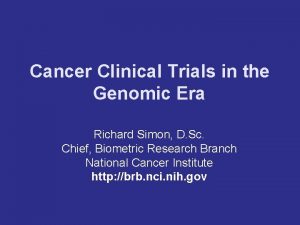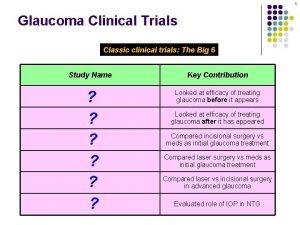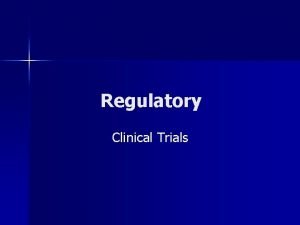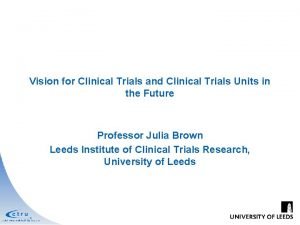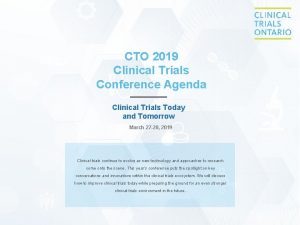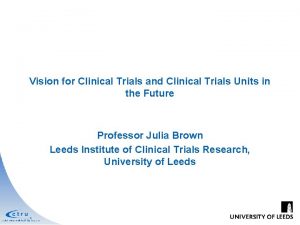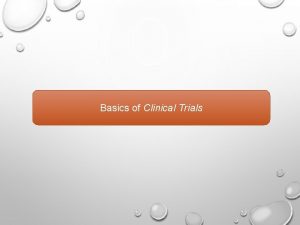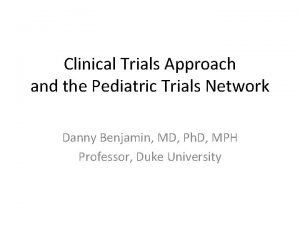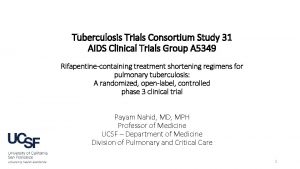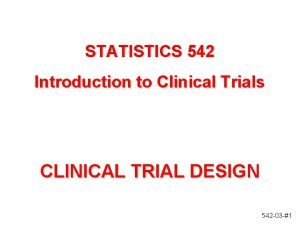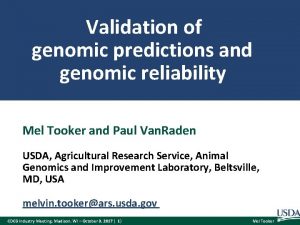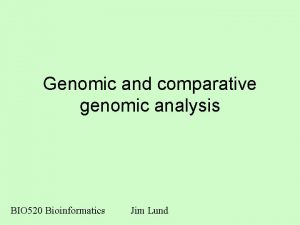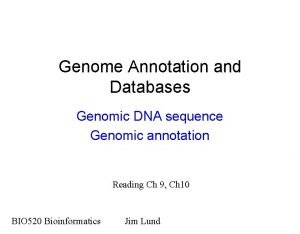Introduction to Design of Genomic Clinical Trials Richard




































- Slides: 36

Introduction to Design of Genomic Clinical Trials Richard Simon, D. Sc. Chief, Biometric Research Branch National Cancer Institute http: //brb. nci. nih. gov

Biometric Research Branch Website brb. nci. nih. gov Powerpoint presentations n Reprints & Technical Reports n BRB-Array. Tools software n Web based Sample Size Planning n

Outline n Introduction n n n n Biomarkers Validation Targeted enrichment design Stratification designs Prospective-Retrospective Designs Prognostic biomarkers Clinical Trial Designs with adaptive identification of indication for treatment Development and Validation of Classifiers with High Dimensional Data

Different Kinds of Biomarkers n Endpoint biomarker n n n A measurement made on a patient before, during and after treatment to determine whether the treatment is working Surrogate endpoint Pharmacodynamic Intermediate endpoint Prognostic biomarkers n Measured before treatment to indicate long-term outcome for patients untreated or receiving standard treatment n Single arm study of patients receiving a particular rx can identify patients with good prognosis on that rx n n Those patients may not benefit from that rx but they don’t need additional rx Predictive biomarkers n Measured before treatment to identify who will benefit from a particular treatment n n Single arm study with response endpoint RCT with survival or dfs endpoint

Cardiac Arrhythmia Supression Trial Ventricular premature beats was proposed as a surrogate for survival n Antiarrythmic drugs supressed ventricular premature beats but killed patients at approximately 2. 5 times that of placebo n

Surrogate Endpoints n n It is extremely difficult to properly validate a biomarker as a surrogate for clinical outcome. It is not sufficient to demonstrate that the surrogate is correlated with clinical outcome n n That responders live longer than non-responders does not establish response as a valid surrogate endpoint Proper validation requires a series of randomized trials with both the candidate biomarker and clinical outcome measured n Demonstrate that differences between randomized treatment arm with regard to the candidate surrogate are consistent with differences with regard to clinical outcome

n It is often more difficult and time consuming to properly “validate” an endpoint as a surrogate than to use the clinical endpoint in phase III trials

Using Intermediate Endpoints Not Established as Surrogates of Clinical Benefit n Biomarkers can be useful in phase I/II studies as measures of treatment effect n n Unvalidated surrogates can also be used for interim “futility analyses” of phase III trials (e. g. seamless phase II/III). The trial should continue accrual and follow-up to evaluate true endpoint if treatment effect on biomarker is sufficient n n they need not be validated as surrogates for clinical benefit Conditional surrogate endpoints Can be used for developing predictive biomarkers in phase II studies or in adaptive signature designs

Prognostic & Predictive Biomarkers n Many cancer treatments benefit only a minority of patients to whom they are administered n n Particularly true for molecularly targeted drugs Being able to predict which patients are likely to benefit would n n n save patients from unnecessary toxicity, and enhance their chance of receiving a drug that helps them Help control medical costs Improve the success rate of clinical drug development


Prognostic and Predictive Biomarkers in Oncology n Single gene or protein measurement e. g. HER 2 protein staining 2+ or 3+ n HER 2 amplification n KRAS mutation n n Scalar index or classifier that summarizes contributions of multiple genes/proteins n Empirically determined based on genome-wide correlating gene expression to patient outcome after treatment

Prognostic Factors in Oncology Most prognostic factors are not used because they are not therapeutically relevant n Most prognostic factor studies do not have a clear medical objective n They use a convenience sample of patients for whom tissue is available. n Generally the patients are too heterogeneous to support therapeutically relevant conclusions n

Pusztai et al. The Oncologist 8: 252 -8, 2003 n n n 939 articles on “prognostic markers” or “prognostic factors” in breast cancer in past 20 years ASCO guidelines only recommend routine testing for ER, PR and HER-2 in breast cancer “With the exception of ER or progesterone receptor expression and HER-2 gene amplification, there are no clinically useful molecular predictors of response to any form of anticancer therapy. ”

Prognostic Biomarkers Can be Therapeutically Relevant <10% of node negative ER+ breast cancer patients require or benefit from the cytotoxic chemotherapy that they receive n Oncotype. Dx n n 21 gene RTPCR assay for FFPE tissue

Key Features of Oncotype. Dx Development n n Identification of important therapeutic decision context Prognostic marker development was based on patients with node negative ER positive breast cancer receiving tamoxifen as only systemic treatment n n Staged development and validation n n Use of patients in NSABP clinical trials Separation of data used for test development from data used for test validation Development of robust assay with rigorous analytical validation n n 21 gene RTPCR assay for FFPE tissue Quality assurance by single reference laboratory operation

B-14 Results—Relapse-Free Survival p<0. 0001 338 pts 149 pts 181 pts Paik et al, SABCS 2003

Predictive Biomarkers n In the past often studied as un-focused posthoc subset analyses of RCTs. Numerous subsets examined n Same data used to define subsets for analysis and for comparing treatments within subsets n No control of type I error n

n Statisticians have taught physicians not to trust subset analysis unless the overall treatment effect is significant This was good advice for post-hoc data dredging subset analysis n For many molecularly targeted cancer being developed, the subset analysis will be an essential component of the primary analysis and analysis of the subsets will not be contingent on demonstrating that the overall effect is significant n





Mutations Copy number changes Translocations Expression profile Treatment


Types of Validation for Prognostic and Predictive Biomarkers n Analytical validation n n Clinical validation n n Pre-analytical and post-analytical robustness Does the biomarker predict what it’s supposed to predict for independent data Clinical utility n Does use of the biomarker result in patient benefit

Clinical Utility Benefits patient by improving treatment decisions n Depends on context of use of the biomarker n Treatment options and practice guidelines n Other prognostic factors n

Clinical Utility of Prognostic Biomarker n Prognostic biomarker for identifying patients n n n for whom practice standards imply cytotoxic chemotherapy who have good prognosis without chemotherapy Prospective trial to identify such patients and withhold chemotherapy n n TAILORx “Prospective plan” for analysis of archived specimens from previous clinical trial in which patients did not receive chemotherapy n Oncotype. Dx

Marker Strategy Design


MINDACT Design

Clinical Utility of Predictive Biomarker n n Predictive biomarker for identifying the patients who benefit from a specific regimen and/or the patients who do not Prospective RCT of new regimen versus control with tissue prospectively collected and assayed and patients classified as test + or test – n n Sample size established to have enough test + patients for separate analysis of new regimen versus control and enough test – patients for separate analysis of new regimen versus control Focused analysis on a single completely prospectively defined biomarker classifier

Prospective Co-Development of Drugs and Companion Diagnostics 1. Develop a completely specified genomic classifier of the patients likely to benefit from a new drug • • Single gene/protein Gene expression signature • • • 2. 3. Screen genes using microarrays Develop classifier for RT-PCR platform Pre-clinical, phase II data, archived specimens from previous phase III studies Establish analytical validity of the classifier Use the completely specified classifier to design and analyze a new clinical trial to evaluate effectiveness of the new treatment with a pre-defined analysis plan that preserves the overall type-I error of the study.

Guiding Principle n The data used to develop the classifier should be distinct from the data used to test hypotheses about treatment effect in subsets determined by the classifier Developmental studies can be exploratory n Studies on which treatment effectiveness claims are to be based should be definitive studies that test a treatment hypothesis in a patient population completely pre-specified by the classifier n

New Drug Developmental Strategy I n Restrict entry to the phase III trial based on the binary predictive classifier, i. e. targeted design

Using phase II data, develop predictor of response to new drugto New Drug Develop Predictor of Response Patient Predicted Responsive Patient Predicted Non-Responsive Off Study New Drug Control

Developmental Strategy (II) Develop Predictor of Response to New Rx Predicted Responsive To New Rx New RX Predicted Nonresponsive to New Rx New RX Control
 Clinical trials quality by design
Clinical trials quality by design Nida clinical trials network
Nida clinical trials network Site initiation visit agenda
Site initiation visit agenda Clinicaltrails.gov api
Clinicaltrails.gov api Role of statistician in clinical trials
Role of statistician in clinical trials Mrc clinical trials unit
Mrc clinical trials unit Stratified randomization
Stratified randomization Phs human subjects and clinical trials information
Phs human subjects and clinical trials information Mpn clinical trials
Mpn clinical trials Clinicaltrials gov prs
Clinicaltrials gov prs Clinical trials
Clinical trials Audits and inspections of clinical trials
Audits and inspections of clinical trials Professor claire harrison
Professor claire harrison Dhl atyrau
Dhl atyrau Clinical hysteria salem witch trials
Clinical hysteria salem witch trials Ohsu clinical trials office
Ohsu clinical trials office Prs registration
Prs registration Clinical trials.gov login
Clinical trials.gov login Pharmaceutical iwr applications
Pharmaceutical iwr applications York trials unit
York trials unit Genomic equivalence
Genomic equivalence Genomic england
Genomic england Genomic england
Genomic england Genomic england
Genomic england Genomic instability
Genomic instability Genomic
Genomic Genomic imprinting definition
Genomic imprinting definition Genomic signal processing
Genomic signal processing Comparative genomic hybridization animation
Comparative genomic hybridization animation Genomic equivalence definition
Genomic equivalence definition Design and analysis of cross-over trials
Design and analysis of cross-over trials Looking for richard stream
Looking for richard stream Introduction to clinical laboratory
Introduction to clinical laboratory Chapter 45 introduction to the clinical laboratory
Chapter 45 introduction to the clinical laboratory Discovery education salem witch trials
Discovery education salem witch trials National geographic salem witch trials
National geographic salem witch trials Malta football trials
Malta football trials
